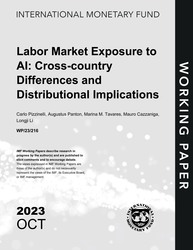
Labor Market Exposure to AI: Cross-country Differences and Distributional Implications
Labor Market Exposure to AI: Cross-country Differences and Distributional Implications
READ MORE...
Volume/Issue:
Volume 2023
Issue 216
Publication date: October 2023
ISBN: 9798400254802
$20.00
Add to Cart by clicking price of the language and format you'd like to purchase
Available Languages and Formats
| English |
Prices in red indicate formats that are not yet available but are forthcoming.
Topics covered in this book
This title contains information about the following subjects.
Click on a subject if you would like to see other titles with the same subjects.
Finance , Labor , Economics- Macroeconomics , Economics / General , Artificial intelligence , Employment , Occupations , Emerging Markets , impact of artificial intelligence , exposure to AI , labor market exposure , employment share , educated worker , Labor markets
Summary
This paper examines the impact of Artificial Intelligence (AI) on labor markets in both Advanced Economies (AEs) and Emerging Markets (EMs). We propose an extension to a standard measure of AI exposure, accounting for AI's potential as either a complement or a substitute for labor, where complementarity reflects lower risks of job displacement. We analyze worker-level microdata from 2 AEs (US and UK) and 4 EMs (Brazil, Colombia, India, and South Africa), revealing substantial variations in unadjusted AI exposure across countries. AEs face higher exposure than EMs due to a higher employment share in professional and managerial occupations. However, when accounting for potential complementarity, differences in exposure across countries are more muted. Within countries, common patterns emerge in AEs and EMs. Women and highly educated workers face greater occupational exposure to AI, at both high and low complementarity. Workers in the upper tail of the earnings distribution are more likely to be in occupations with high exposure but also high potential complementarity.
Copyright © 2010 - 2025
Powered by:
AIDC



